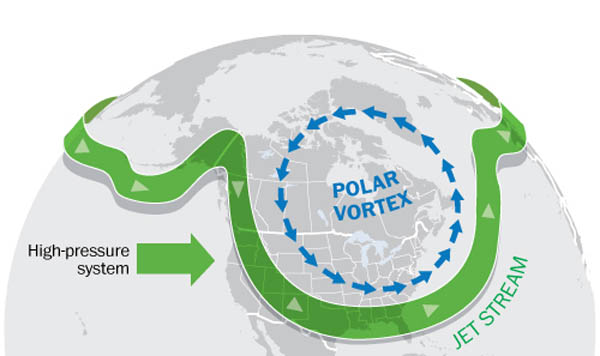The polar vortex, also known as the polar cyclone first appeared on the map in 1853. Today the polar vortex hovers over central and eastern United States while the west is in a drought. The storm rotates in a counter-clockwise motion that will last the winters of 2013 and 2014. The polar vortex will eventually weaken as summer and spring close in.
“We can’t make it rain, but we can be much better prepared for the terrible consequences that California’s drought now threatens, including dramatically less water for our farms and communities and increased fires in both urban and rural areas,” stated Governor Edmund G. Brown Jr.
The volcanic eruptions in the tropics lead to a stronger polar vortex during the winter for as long as two years afterwards. When the polar cyclone weakens, the general flow pattern across the mid-latitudes buckle weakens which causes the significant cold outbreaks.
Temperatures drop quickly in cities such as New York, Chicago, Minneapolis, Indianapolis, and the state of North Dakota. The high is 16 degrees Fahrenheit and the low is -35 degrees Fahrenheit. The wind chill and snow has caused 4,392 flights to be cancelled and 3,577 delayed. The ground crews are allowed to stay outside for only 15 minutes at a time. Train stations are also delayed up to 48 hours across Illinois, Iowa, Minnesota, Missouri and Wisconsin.
Any uncovered flesh can freeze and result in frost bite in only 5 minutes. Majority of schools are closed, there are no cars roaming the roads and many work days have been cancelled. Even though people are completely covered, the cold air can go through some clothes; frost bite is still an option.
“This is possibly one of the worst droughts California has seen since records began being kept about 100 years ago,” mentioned Governor Brown.
While the east and central United States are going through a tough time, the west is begging for some rain. The western states have been in a long drought and have experienced degrees up to 70 in January. At this time, it’s supposed to be cold and wet, but it’s everything but that. Meteorologists have claimed this year to be one of the driest years in California we’ve had in a while. Many states in the west desperately need rain. We are all caught in an extreme drought and if we don’t get rain soon it will start hurting us economically.
“I’m calling all Californian’s to conserve water in every way possible,” said Governor Brown.
California’s had to reduce water consumption by 20 percent. The state rivers and reservoirs, including the Sacramento and San Joaquin rives are below their records. This is the third straight year with below normal rainfall in California.
